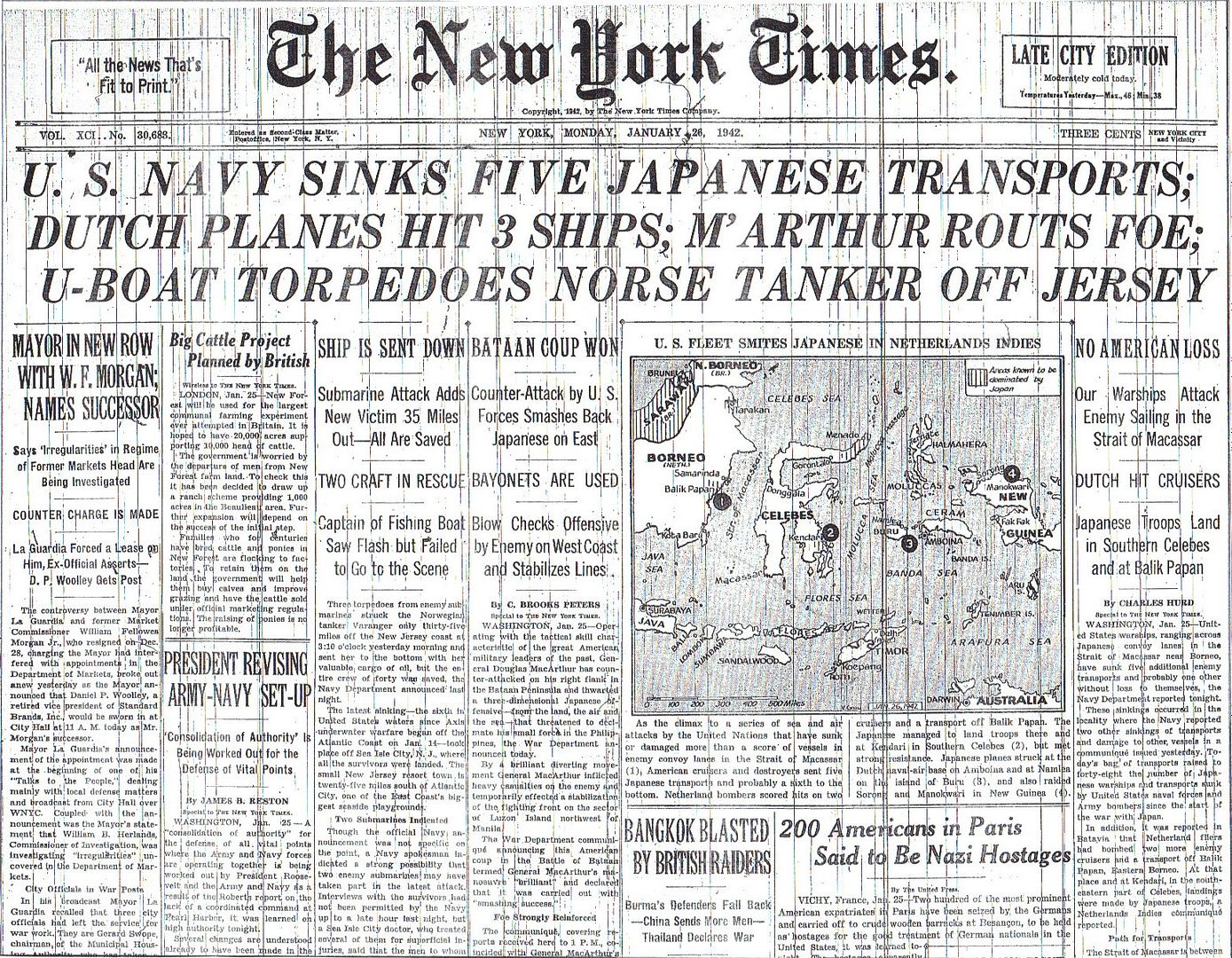
Posted on 01/26/2012 4:47:51 AM PST by Homer_J_Simpson


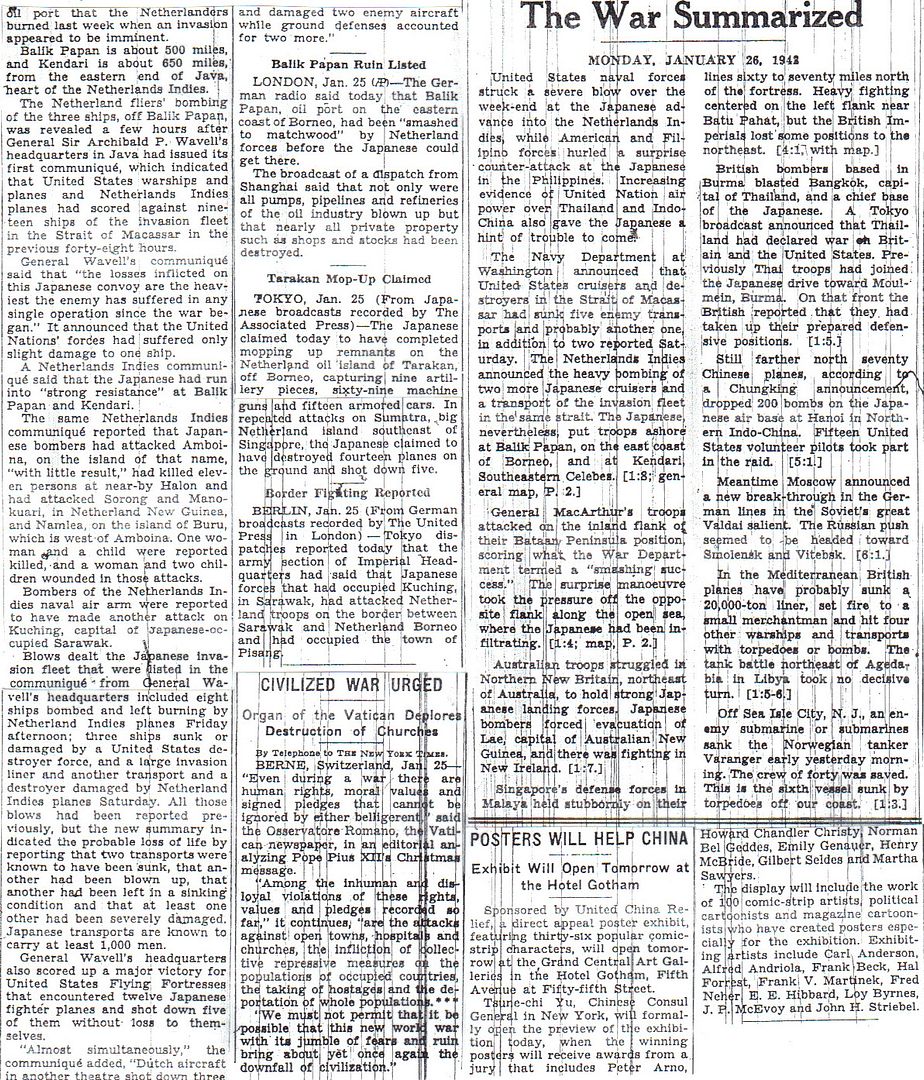
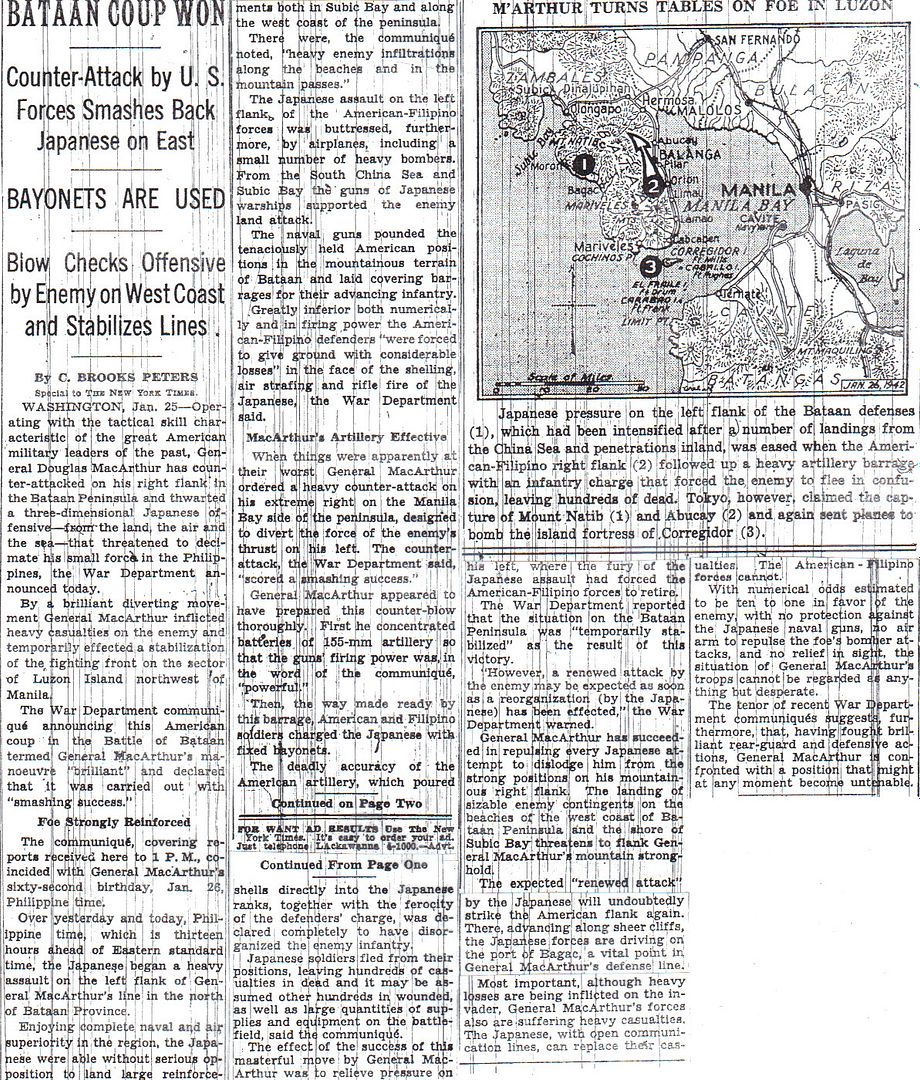
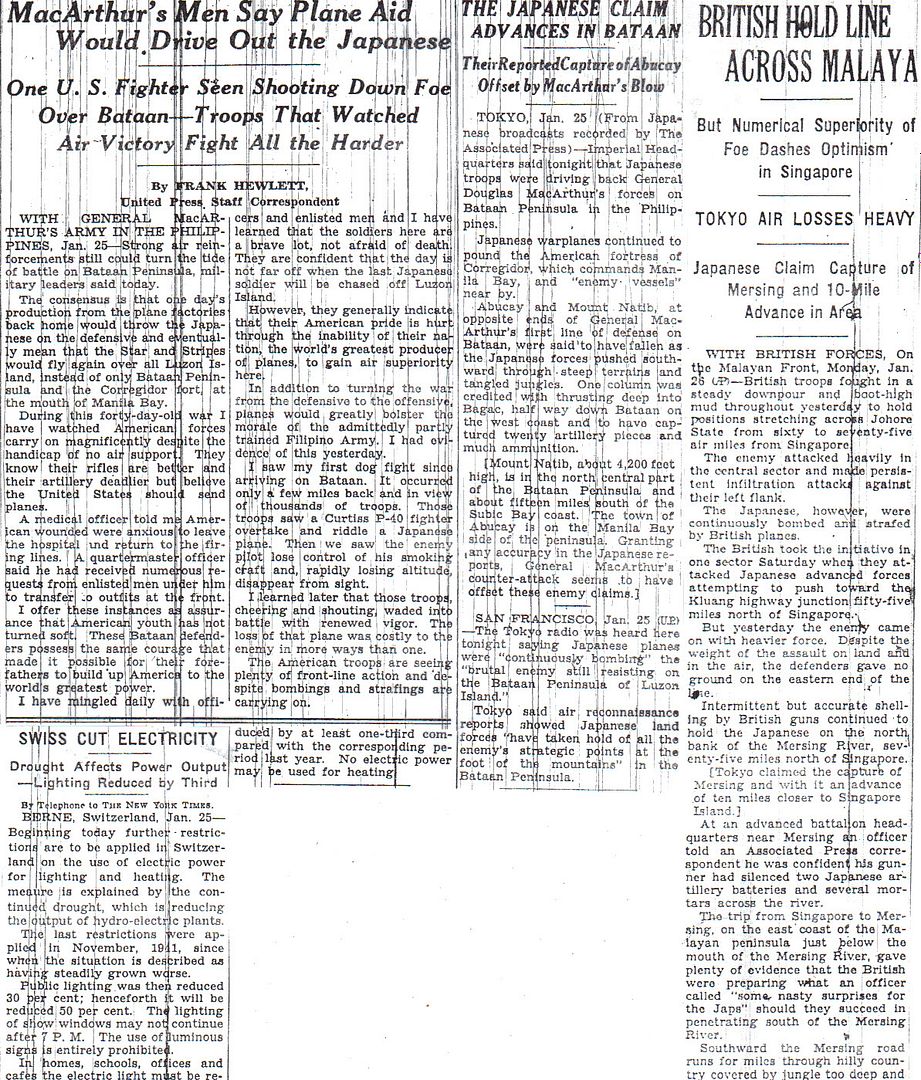
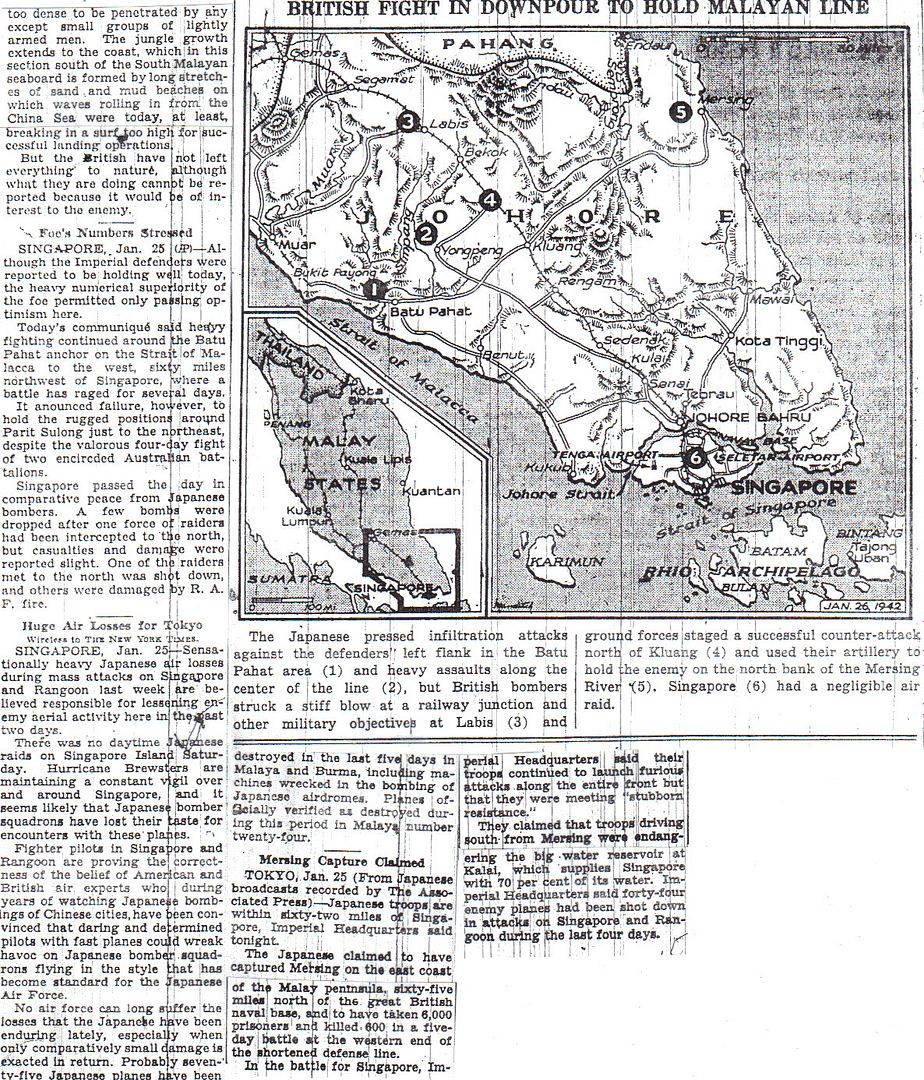

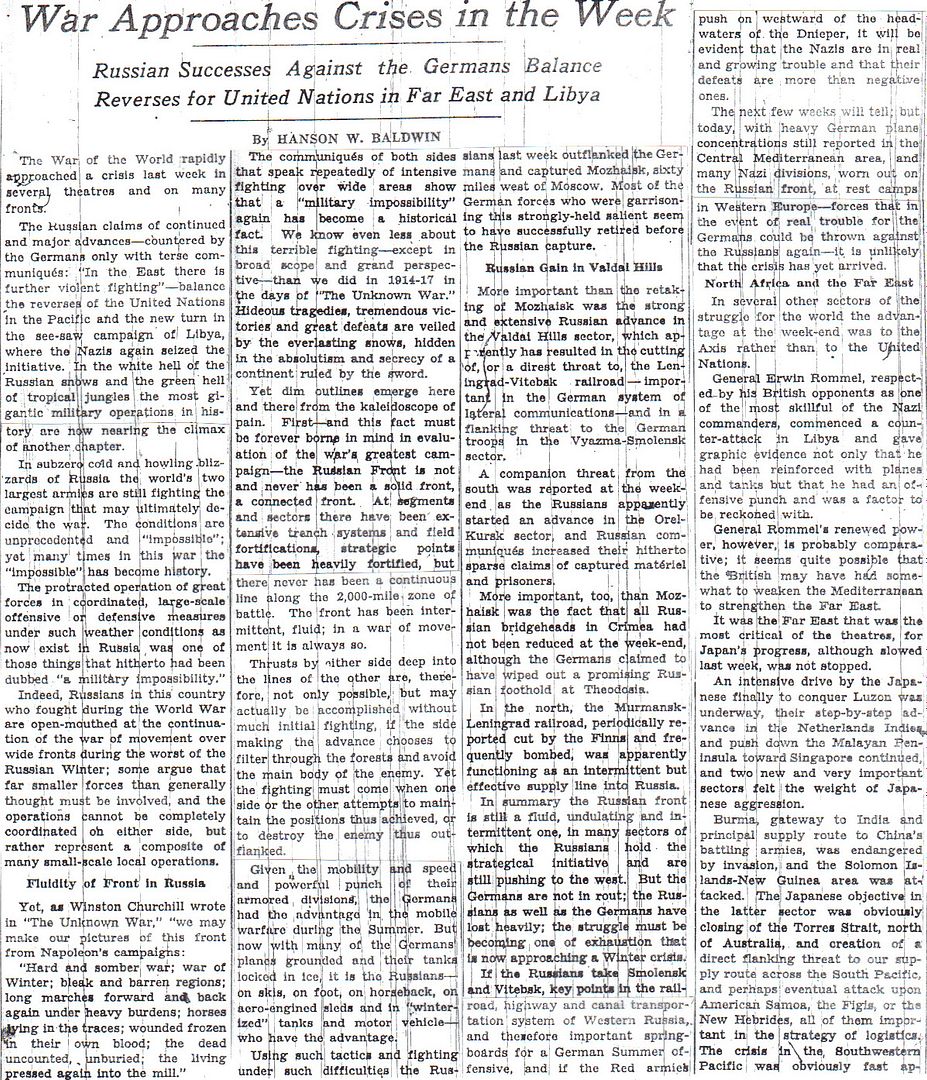
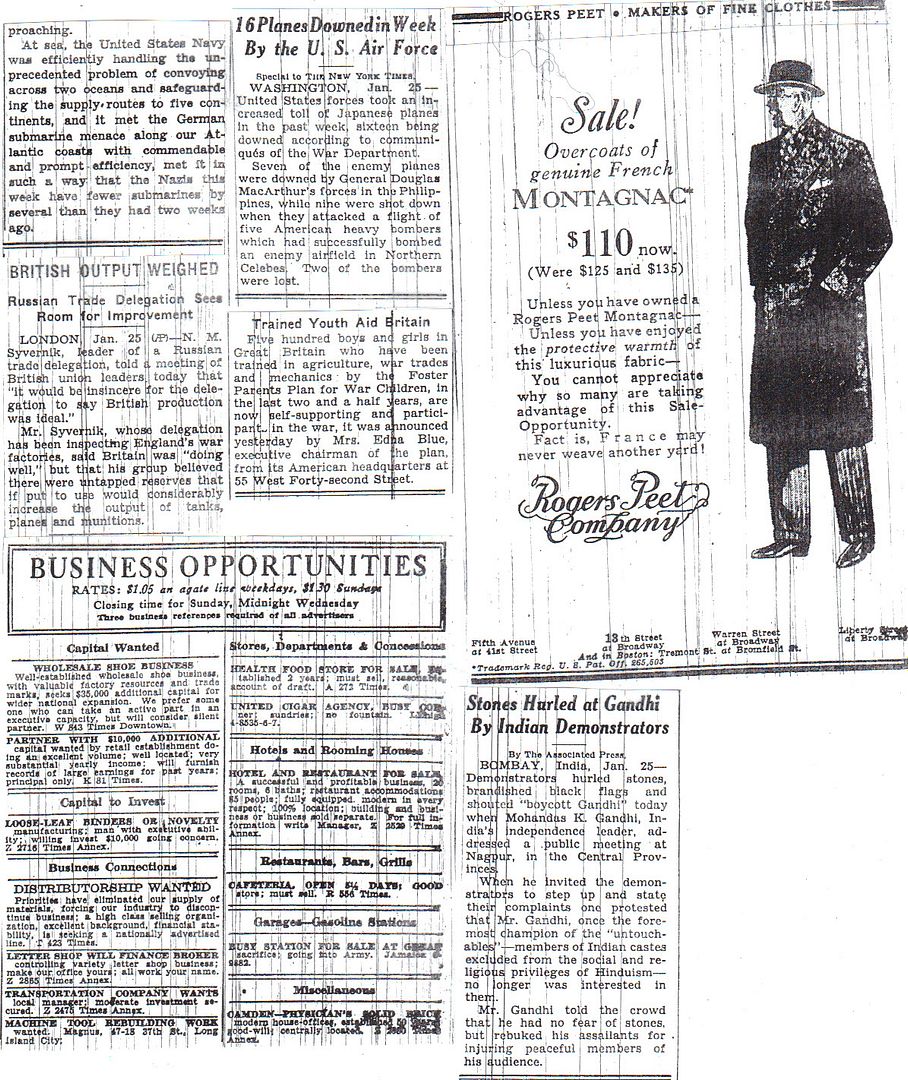
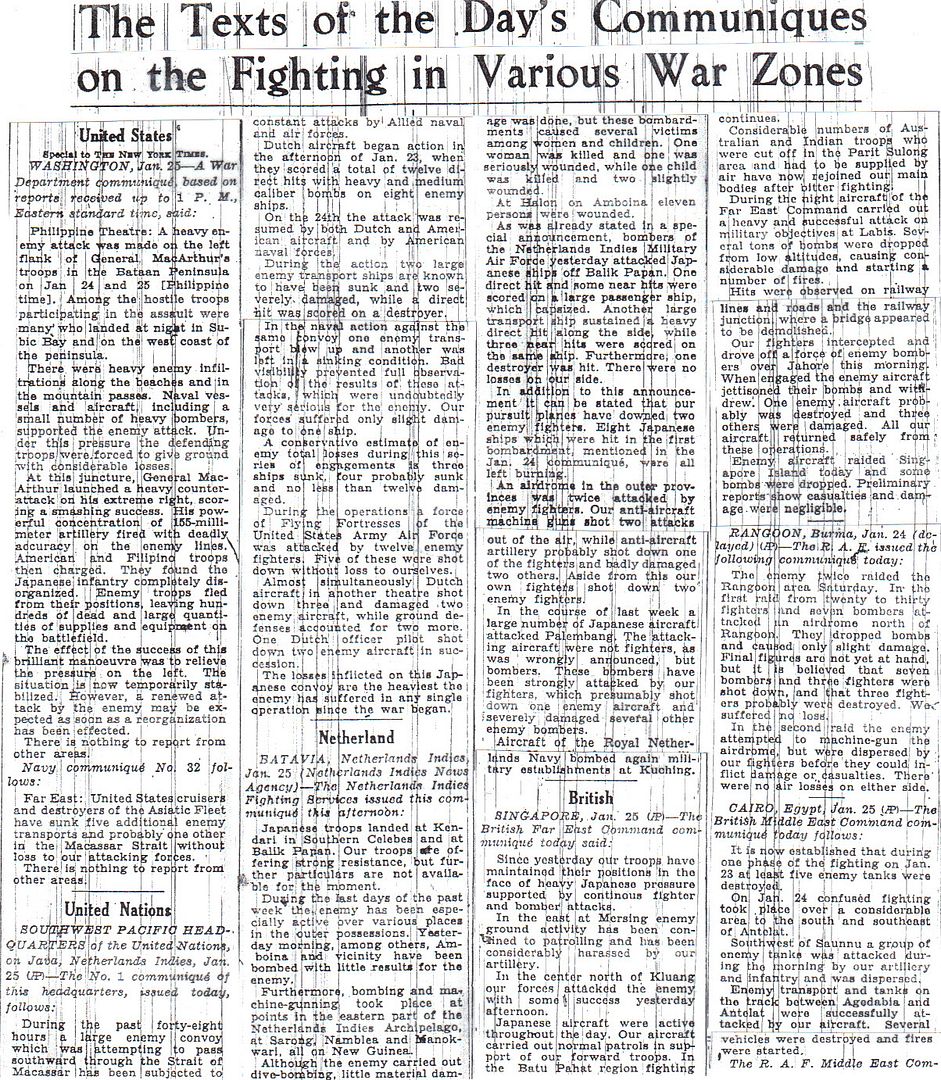

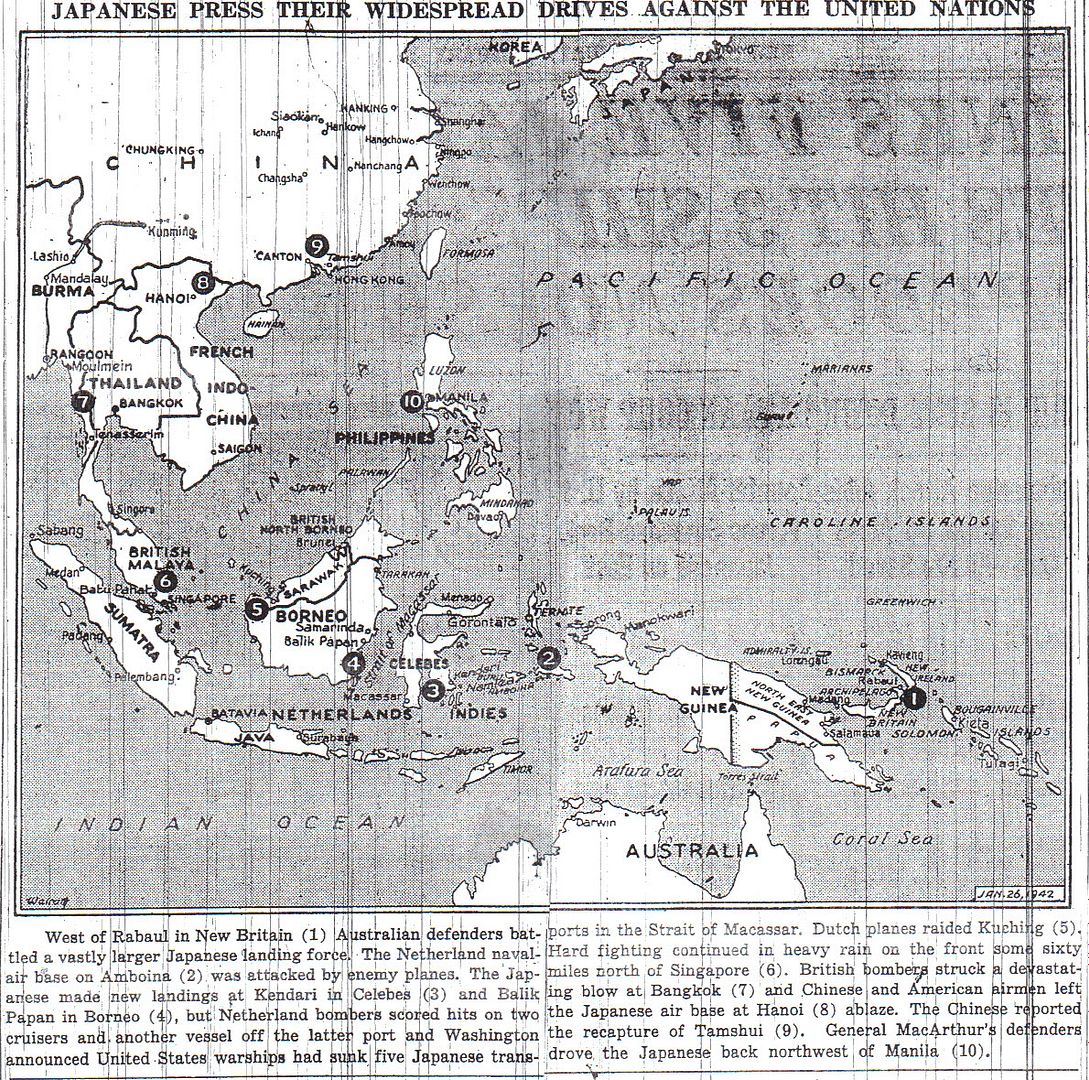
Very impressive. Thank you. I’ll pore over this later.
http://www.onwar.com/chrono/1942/jan42/f26jan42.htm
Kimmel and Short responsible for disaster
Monday, January 26, 1942 www.onwar.com
In Washington... The Board of Inquiry established to investigate Pearl Harbor find Admiral Kimmel, (then Commander in Chief, US Fleet) and General Short (then Commander in Chief, Hawaii Department) guilty of dereliction of duty. Both have already been dismissed.
In North Africa... The continuing German offensive recaptures Msus.
In Britain... The arrival of the first American soldiers in the Britain isles.
http://homepage.ntlworld.com/andrew.etherington/month/thismonth/26.htm
January 26th, 1942
UNITED KINGDOM: The first US troops arrive in Northern Ireland. They are troops of the 133d Infantry, 34th Division.
Belfast: The first American soldiers have arrived in the British Isles. Air and naval squadrons arrived three weeks ago, but without the fanfares which today greeted the first of many thousand “Doughboys” destined for Europe.
Landfall for today’s arrivals - an infantry division from Iowa - was Northern Ireland, where they are to guard war stocks supplied under Lend-Lease. Many of them are of German or Irish extraction. If some of their cousins are less than happy about their return to uniform, the British are euphoric. The Duke of Abercorn, the governor of the province, John Andrews, the Ulster premier, and Sir Archibald Sinclair, the air minister, welcomed them ashore, as did the Royal Ulster Rifles band with its own version of “The Star-Spangled Banner”. Sir Archibald said that their arrival marked a new stage in the world war - “a gloomy portent for Mr. Hitler.”
Minesweeper HMS Antares laid down.
Destroyer HMS Verulam laid down.
Minesweeper HMS Boston commissioned. (Dave Shirlaw)
FRANCE: Paris: A simple matchbox can open many a door. The one that Jean Moulin always carries around contains microfilmed orders from General de Gaulle.
Moulin, known as “Max” was formerly mayor of the town of Chartres and escaped to England nearly five months ago. Ever since he parachuted back into France on 1 January, the top-secret contents of the matchbox have been his letter of introduction to the leaders of the Resistance in the southern sector. De Gaulle has ordered him to unit the Resistance movements under the Free French banner. Despite some qualms, Henri Frenay, the leader of the Combat group, was first to rally to de Gaulle. Moulin then travelled to Avignon, Nimes, Valence and finally, Lyons, where he met Raymond Aibrac of the Liberation group.
These initial contacts between the various heads of the anti-Nazi movement did not always go without a hitch. Resistance leaders are not on the whole keen to relinquish their hard-won independence and authority, particularly since de Gaulle has so far only given them a few vague promises in exchange for their support and allegiance.
What they have not seen are the money, arms, ammunition and explosives for which they have been calling so desperately.
GERMANY: The RAF bombs Hanover. (Jack McKillop)
LIBYA: German troops recapture Msus, crushing the British 2nd Armoured Brigade.
The German advance is stalled by a sandstorm. (Jack McKillop)
BURMA: AVG pilot Louis Hoffman is lost in action against the Japanese. (Chuck Baisden)
Pilots of the 1st and 2d Fighter Squadrons, American Volunteer Group (AVG, aka, “The Flying Tigers”) shoot down three Japanese Army fighters over Rangoon at 1100 hours local. (Jack McKillop)
MALAYA: A Japanese convoy carrying reinforcements approaches Endau. They are attacked by nine RAAF Hudson and 12 Vildebeestes; no ships are hit and 5 of the Vildebeestes are shot down. In the evening, the old destroyers HMAS Vampire and HMS Thanet sail to attack the Japanese convoy. (Jack McKillop)
NETHERLANDS EAST INDIES: Lieutenant General Sir John Lavarack, General Officer Commanding I Australian Corps, arrives in Java as the advance party of Australian troops preparing to leave the Middle East. Lavarack is soon convinced that the situation is “grim” and believes that the Japanese might seize southern Sumatra before the main body of his command arrives. (Jack McKillop)
BORNEO: After occupying Balikpapan yesterday, the Japanese mop up the surrounding area today and then the troops begin repairing the airfield. (Jack McKillop)
PHILIPPINE ISLANDS: On Bataan, the Philippine II and I Corps complete their withdrawal to the final defence line on Bataan in the morning, closely followed by the Japanese. The new line, which is to be continuous for the first time, extends from Orion on the east to Bagac on the west and is generally behind the Pilar-Bagac road. Gaps develop in each corps sector when HQ U.S. Army Forces, Far East (USAFFE) withdraws the Philippine Division as its reserve. Units are hastily shifted to replace the U.S. 31st and Philippine Scouts (PS) 57th Regiments in the II Corps line and the PS 45th Infantry in the I Corps line. The II Corps, responsible for eastern Bataan from the coast to the Pantingan River, organizes its line into four sectors, from east to west: Sector A, 31st Infantry of 31st Division, Philippine Army (PA); Sector B, Provisional Air Corps Regiment; Sector C, elements of the 31st and remnants of the 51st Divisions, PA; Sector D, the 41st and 21st Divisions, PA, and 33d Infantry, less the 1st Battalion, of the 31st Division, PA. In addition, the beach defence forces are organized as Sector E. 1st Battalion of the 33d Infantry, 31st Division, PA, and a regiment of the PA combat engineers constitute corps reserve. The Japanese patrol along the eastern slopes of Mt Samat almost to the main line of resistance but do not discover a gap in the line, which exists for several hours. The I Corps line, extending from the Pantingan River to the west coast, is divided into Right and Left Sectors: the Right Sector is manned by the Philippine Constabulary’s 2d Regiment (less one battalion) on the east and the 11th Division, PA, on the west; disposed in the Left Sector are elements of the 1st Division, PA, on the east and 91st Infantry, PA, on the west. Beach defence forces make up the South Sector. The 26th Cavalry, Philippine Scouts (PS), is held in corps reserve. The Japanese open an offensive, driving south along West Road toward the Binuangan River. The 91st Division, PA, contains these attacks. In the South Sector, the Japanese maintain beachheads at Quinauan and Longoskawayan Points and move reinforcements toward the former. USAFFE sends the 88th Field Artillery, PS, from the west coast from II Corps sector, one of its gun batteries to Quinauan Point and another to Longoskawayan Point. (Jack McKillop)
During the night, the few remaining P-40s on Bataan bomb and strafe Nichols and Nielson Fields on Luzon. (Jack McKillop)
AUSTRALIA: Minesweeper HMAS Cessnock commissioned. (Dave Shirlaw)
U.S.A.: The Board of Inquiry which has been investigating the Pearl Harbor Attack releases its findings.
Destroyer USS Macomb commissioned. (Dave Shirlaw)
PERU: Lima breaks off diplomatic relations with Berlin. (Mike Yared)
PARAGUAY: Montevideo breaks off diplomatic relations with the Axis powers. (Dave Shirlaw)
ATLANTIC OCEAN: Armed but unescorted U.S. freighter SS West Ivsis is torpedoed and sunk by German submarine U-125 off the eastern seaboard. The U-boat had fired and at first missed the ship. But the second torpedo broke her in two, sinking in 14 minutes. There are no survivors from either the 36-man civilian crew or the 9-man Armed Guard who had to operate the 4in gun (the ship also had four 50 cal. and four 30 cal. aboard). (Jack McKillop and Dave Shirlaw)
SS Traveler sunk by U-106 at 40N, 61.45W - Grid CB 5172. (Dave Shirlaw)
U-404’s periscope was damaged during an air attack in the North Atlantic.
U-753 was rammed and damaged in an attack by a British escort in the North Atlantic. (Dave Shirlaw)
"This woman awaits execution in the Belzec death camp, as pleas for her life fall on deaf ears.
About 600,000 people, virtually all of them Jews, died at Belzec."
The Jewish Army ad is very interesting!
The images you post tend to stick in your mind for a while. One that you posted a while back, a man and woman being hanged as partisans, I recognized instantly. I last saw it maybe fifty years ago. It was not buried very deeply in my subconscious. This is another one like that.
Headline: "CIVILIZED WAR URGED"
BERNE, Switzerland, Jan 25 -- "Even during a war there are human rights, moral values and signed pledges that cannot be ignored by either belligerent" said the Osservatore Romano, the Vatican newspaper, in an editorial analyzing Pope Pius XII's Christmas message."Among the inhuman and disloyal violations of these rights, values and pledges recorded so far," it continues, "are the attacks against open towns, hospitals and churches, the infliction of collective repressive measures on the populations of occupied countries, the taking of hostages and the deportation of whole populations."
"We must not permit that it be possible that this new world war with its jumble of fears and ruin bring about yet once again the downfall of civilization."
The deportation of whole populations will be the lasting legacy of this war, having been practiced by all sides in the conflict.
THE point where the Tigoda river runs into the Volkhov was the junction between the German 61st and 21st Infantry Divisions.
These junctions were always vulnerable and a favorite target for Russian attacks. The Russians had found from experience that the overlapping command pattern along these junctions made it more difficult to clear up any penetrations. Who was responsible for sealing off a penetration along a junction?
No commander ever was particularly anxious to do so himself; he would much rather leave the responsibility to his neighbor. For that reason special "junction reserves" had been a customary thing in the First World War. But the weak German Eastern Front was only rarely able to afford such a luxury during the winter of 1941-42.
" That damned junction, of course," Colonel Lohmeyer cursed as, on 3rd January 1942, he received the curt and clear-cut order from the command of 291st Infantry Division: " Enemy forces which have penetrated between 61st and 21st Infantry Divisions at the mouth of the Tigoda must be thrown back and the main fighting-line restored."
The East Prussians of the Elk Division had been withdrawn from the line only a few days previously for rest and replenishment. But what was the use?
With his well-tried 505th Infantry Regiment and part of an SS Battalion of the 9th ("Death's Head ") SS Regiment, newly arrived from Finland, Lohmeyer flung himself against the Soviet ski battalions which had penetrated at the mouth of the Tigoda. It was a fantastic kind of fighting in chest-deep snow, 42 degrees below, in thick forest matted with impenetrable undergrowth.
In the early evening of 4th January Colonel Lohmeyer, the hero of Liepaja, was killed in a forest by an enemy mortar bomb. The news spread like wildfire and was a profound shock to the regiment. Colonel Hesse took over command and with the angry battalions of 505th Infantry Regiment cleared up the Soviet penetration. But the attack they had repulsed at the mouth of the Tigoda was not the expected Soviet full-scale attack. During those first few days of the New Year there was fierce local fighting everywhere between Kirishi and Novgorod. The Russians were prodding the Volkhov front to find its weak points; they were carrying out reconnaissance in force to identify German positions and units; they were searching for a gap through which they could thrust. The old-timers could feel it in their bones: something was in the air, a large-scale attack was imminent. When would it come? And where? Those were the agonizing questions.
Major Rüdiger, commanding the Intelligence detachment of 126th Infantry Division, heaved a sigh of relief when a monitoring company NCO knocked at his door late in the evening of 12th January and brought him an intercepted and decoded signal from the Soviet Fifty-second Army to its 327th Rifle Division: " Positions to be held at all costs. Offensive postponed. Continue feinting attacks."
So there was not going to be an offensive after all—at least not in this sector, Rüdiger concluded. He immediately rang up Lieutenant-General Laux, his C.O. Laux, an experienced officer, thanked him for the information, but added, "I wouldn't trust those fellows too far."
The contents of the intercepted radio signal soon spread about. When, therefore, Soviet artillery started shelling the German positions over a broad front at 0800 hours on the following morning, 13th January, the troops did not take it too seriously. But after a while things began to look suspicious.
The heavy bombardment did not look like a blind. The guns then lengthened their range beyond the German lines. The time was 0930. Under the massive artillery umbrella numerous packs of infantry emerged from the haze of the dawning winter day, and ski detachments came gliding over the ice of the Volkhov. "The Russians are coming!"
The radio signal of the night before had been a Soviet ruse to deceive the German command. The battle of the Volkhov had begun: it had started north of Novgorod, at the junction between 126th and 215th Infantry Divisions. By 1030 hours the Soviets had established their first bridgehead across the Volkhov at Gorka, in the sector of 422nd Infantry Regiment, and had broken into the German main fighting-line.
Colonel Harry Hoppe, the conqueror of Schlüsselburg, mounted an immediate counter-attack with units of 424th Infantry Regiment and sealed off the penetration. But he did not succeed in regaining the old main fighting-line.
In the morning of 14th January the enemy attacked again, and strong formations succeeded in infiltrating through the snowbound forests into the rear of the German positions. By nightfall the spearheads of fast Soviet ski battalions stood in front of the gun emplacements of the divisional artillery. The German gunners defended themselves with trenching-tools, carbines, and pistols and repulsed the Soviets.
But for how long?
While Division and Corps were still convinced that the main weight of the Soviet attacks was in the sector of 422nd Infantry Regiment, a far greater disaster was unrolling farther north, in the Yamno-Arefino area.
It was there, at the junction between 126th and 215th Infantry Divisions, where the sectors of the two wing regiments, 426th and 435th Infantry Regiments, abutted, that the Soviets had concentrated their main effort.
On a very narrow front, therefore, the crack Soviet 327th Rifle Division and the superbly equipped independent 57th Striking Brigade charged across the Volkhov against the positions of the three weakened battalions of a single German regiment—426th Infantry Regiment under Lieutenant-Colonel Schmidt.
Simultaneous Soviet attacks on 435th Infantry Regiment, lying on the left of the 426th, prevented help being sent from there. Skillfully taking advantage of deep hollows in the ground in front of the German main fighting-line, the Soviets punched their way into the German positions, cracked the line of strongpoints, and, with the bulk of XIII Cavalry Corps of the Second Striking Army, swept like a tidal wave through the burst dike into the hinterland. Ceaselessly the Russians pumped reinforcements through the two-to-three-mile gap and pressed on towards the Novgorod-Chudovo road.
In a cutting cold of 50 degrees below zero the dispersed German companies hung on to clearings in the woods and to high snowdrifts and made the Soviets pay heavily for their slow advance. It took the Russians four days to cover the five-mile distance to the road. And when they did reach the road they had not gained much, for three German strong-points continued to hold out firmly along it like pillars against the battering waves—Mostki, Spasskaya Polist, and Zemtitsy.
Surrounded by the enemy, these strongpoints held on for weeks in the rear of the Soviet flood. They became focal points in the fighting for the vital road, the north-south link of the Volkhov front.
By 24th January the Russians had pumped sufficient forces into the penetration to launch their drive in depth. With cavalry, armor, and ski battalions they raced boldly through the narrow—in fact, all too narrow—bottleneck towards the northwest. It was a perfect breakthrough. But its base was dangerously narrow. What were the Russians after?
Were their operations aimed against Leningrad, or did they have other, more far-reaching intentions? That was the question agitating the German Staff. They did not have to worry their heads very long. After eight days the spearheads of the Soviet assault regiments were already 55 miles behind the German front.
If they were aiming at Leningrad they had covered half the distance.
On 28th January Russian forward detachments attacked Yeglino. The direction of the attack, therefore, was towards the north-west, bypassing Leningrad in the South, towards the Soviet-Estonian frontier. We know to-day that the big drive outflanking Leningrad was in fact originally intended to go as far as Kingisepp—a more than optimistic idea. But then the Russians suddenly stopped at Yeglino and, instead of continuing westward, swung north-east towards Lyuban, on the Chudovo—Leningrad road. Were they aiming at Leningrad after all?
General of Cavalry Lindemann, who had succeeded to the command of Eighteenth Army when Field-Marshal von Küchler took over Army Group North on 15th January, needed only one glance at the large situation map in order to read the Russian intentions. Their penetration area, the bottleneck through which they were pouring, was too narrow and their exposed flanks were too long. To advance farther would have been foolhardy.
Since the Soviet Fifty-fourth Army was just then attacking the German 269th Infantry Division at Pogostye, south of Lake Ladoga, the Russian intentions were clearly revealed by the map: to begin with, the German I Corps was to be annihilated in a pincer operation.
"We must be prepared for anything and not lose our nerve," remarked General of Infantry von Both, commanding the East Prussian I Corps in Lyuban, as the commander of the Corps headquarters started issuing carbines and machine pistols to the officers and clerks.
Not to lose one's nerve— that was the problem.
The 126th Infantry Division has been severely blamed for allowing the Russians to break through in its sector. That is unfair. No regiment of any other weakened division on the Eastern Front could have held this concentrated Soviet attack.
In judging the 126th Infantry Division one should remember not so much the Soviet break-through as the fact that this division continued to hold the flanks and cornerstones of this barely 20-mile-wide gap day after day against the onslaught of Soviet combat groups, and by doing so prevented the penetration from being widened.
In spite of continuous costly attacks the Russians did not succeed in widening their narrow corridor.
They left some 15,000 dead in front of the positions of 126th Infantry Division. This circumstance presently had dramatic consequences. It was Colonel Harry Hoppe, the hero of Schlüsselburg, and his 424th Infantry Regiment who enabled a new main fighting line to be established along the southern edge of the penetration.
The northern edge was held with admirable steadfastness by the 215th Infantry Division under Lieutenant-General Kniess. A vital contribution was made by the stubborn defense of the strongpoints Mostki, Spasskaya Polist, and Zemtitsy. There the "Brigade Köchling," an ad hoc collection of units from fifteen different divisions, defended the strongpoints throughout, many weeks.
Exemplary resistance was offered in Zemtitsy by Captain Klossek with his 3rd Battalion, 422nd Infantry Regiment. If any proof was needed that Hitler's blunt and uncompromising hold-on order and its self-sacrificing observance by the men could in certain conditions avert disaster and create the prerequisite for future successful operations, then this proof was supplied by the battle on the Volkhov.
Some 125 miles away from the Volkhov front, meanwhile, the 58th Infantry Division from Lower Saxony was still holding the Leningrad suburb of Uritsk—the same division which nearly six months previously had reached the first tram-stop of Leningrad and thus, virtually, the cradle of the Red revolution. " All unit commanders to report to Divisional HQ at 1100 hours for a conference!"
Telephones rang. " Conference with the General," the telephonists informed their friends at battalion and company level.
" Something's up," they added.
The date was 1st March 1942, General Altrichter, the OC 58th Infantry Division, greeted his officers.
They all suspected that their division was to be once again employed on some special mission.
" Bound to be Volkhov," the officers muttered to each other.
A fortnight previously Lieutenant Strasser with his 9th Battery, 158th Artillery Regiment, had moved off towards Volkhov together with the Emergency Battalion Lörges as a "ski battery." A week later further batteries had been dispatched towards Novgorod. Their surmise was quickly confirmed. " Gentlemen," Altrichter opened the conference, " we have been assigned a task which will have a vital effect on the overall situation."
" Volkhov after all," Colonel Kreipe, commanding 209th Infantry Regiment, said softly to his neighbor, Lieutenant-Colonel Neumann.
General Altrichter had heard him. He nodded and continued: "58th Division has been chosen to be the striking division for sealing off the Volkhov penetration from the south and encircling the enemy forces which have broken through."
Friedrich Altrichter, a doctor of philosophy and the author of interesting essays on military education, formerly on the staff of the Dresden Military College, was good at explaining strategic problems. Many a German officer had passed through his class.
He died in Soviet captivity in 1949.
Altrichter stepped up to the large situation map and began his lecture: "You see what the situation is: the enemy has already driven deep into our lines, and in strength. Frontal engagement can no longer lead to success since we don't have the inexhaustible reserves that would be necessary for that kind of operation. Our only chance is to strike at the Russians at the basis of their operation, at the breakthrough point-to pinch them off and thus to isolate the forces which have penetrated. Fortunately, the 126th and 215th Infantry Divisions have once more established firm fronts along the edges of the bottleneck, and we shall be able to assemble under their cover. We shall strike at the gap from the south. The SS Police Division will attack from the north. Rendezvous is the clearing known as Erika. The regiments of 126th Infantry Division and all other formations employed there, including the battalions of the Spanish Blue Division, which have fought splendidly so far, will be subordinated to us. With these forces we should be able to manage it. And we've got to manage it -otherwise Eighteenth Army is lost. But if we succeed in closing the trap, then we shall have the bulk of two Soviet Armies in the bag."
There was silence in the small room. Then a clicking of heels. Outside it was still bitterly cold.
" Volkhov," the whisper ran through all the unit offices. Volkhov. The men looked it up on their maps. " Some 125 miles to the south of us. And in this weather," they grumbled.
Preparations were complete by 15th March. About 15th March, in Western and Central Europe, people began to think of the spring. But on the Volkhov the temperature was still 50 degrees below zero.
The snow lay four feet deep in the thick forests. The Russians knew what was at stake at their penetration point, and had therefore strengthened it as much as possible. Along the stretch of road controlled by them flame-throwers had been installed and thick minefields laid across all negotiable clearings.
The 220th Infantry Regiment charged the Soviet barriers with its captured enemy tanks and its sapper assault detachments. Fighter-bombers and Stukas of 1 Air Corps dropped their bombs on Soviet positions and strongpoints. But the deep snow cushioned the bomb bursts, and the blast effect was slight. The Russians held their block, and 220th Infantry Regiment did not get through.
Things went better two miles farther west. There the battalions of 209th Infantry Regiment fought their way forward step by step through the clearings of an almost impenetrable snow-bound forest. The 154th Infantry Regiment likewise struggled through the undergrowth, with self-propelled guns and sappers clearing a path for them. Savage small-scale fighting raged throughout the forest. Time and again the mortars failed in the severe cold: ice kept forming inside the barrels so that the bombs no longer fitted. The gunners had shells bursting inside their barrels because the rifling kept icing up. Machine-guns packed up because the oil got stiff and sticky. The most reliable weapons were hand-grenades, trenching-tools, and bayonets.
Towards 1645 hours on 19th March the most forward units of 2nd Battalion, 209th Infantry Regiment, under Major Materne made their way across the clearing marked on their maps with "E"—known to them as clearing Erika.
It is a name well remembered by every one who fought on the Volkhov. It marks a patch of dismal, hotly contested forest. Along the wooden road constructed across this clearing and serving as a supply route a trooper had erected a notice board with the words " Here begins the asshole of the world." For many months it remained in the same spot where, on that 19th March, the spearheads of Materne's battalion were lurking. A machine-gun was stuttering from the far end of the clearing. "That's a German m.g.," one of the men said.
" Better be careful, boys," warned Major Materne. A white flare soared up on the far side. " Answer it " Materne commanded.
A white fiery ball, like a miniature sun, hissed over the clearing. At the far end a figure wrapped up to the tip of his nose and wearing a German steel helmet emerged from behind a bush, and waved. " Ours!" The men were beside themselves with joy.
Through the snow they raced towards each other, slapped each other's backs, fished out cigarettes, and pushed them between each other's lips. " What do you know," they said to their pals from the forward assault detachments of the SS Police Division.
" What do you know-we made it!"
They had made it. The breach was sealed. They had linked up at the clearing Erika, and they had cut the supply route of the Soviet Second Striking Army.
Two Soviet Armies were in the bag. As at Rzhev and at Sukhinichi, the unshakable resistance offered by individual units had created the prerequisites for retrieving a seemingly hopeless situation by means of bold counter-blows and for snatching the initiative from the Russian Armies, grown overconfident and careless through a taste of victory. Once more the hunters became the hunted and the pursued became the pursuers.
Thus the Soviet assault against the Volkhov was halted and their attempt to relieve Leningrad foiled. But what was happening in the meantime on the strip of land between Lakes Ilmen and Seliger, where five Soviet Armies had broken through and torn a wide gap in the front between Army Group Centre and Army Group North?
On this strip of land only two German barriers were left to stem the Soviet flood—Demyansk and Kholm—and everything now depended on them.
If these two strongpoints were over-run or swept away the Soviet Armies would have a clear road into the deep, virtually undefended hinterland of the German front. In the Demyansk area there were six German divisions barring the way to the Russians. Other formations—such as units of 290th Infantry Division, which had held their ground when the Russians broke through at Lake Ilmen and had subsequently been unable to withdraw from their partial encirclement towards Staraya Russa—later broke through in a south-easterly direction to reach II Corps and thus reinforced the defenders of the Demyansk pocket.
The II Army Corps under General Count Brockdorff-Ahlefeldt drew the bulk of the Soviet attacking forces of five Armies and tied them down. The Soviet Third Striking Army, advancing farther south, was likewise unable to make any progress in the face of the second immovable barrier across the otherwise empty gap between Demyansk and Velikiye Luki, a barrier blocking the road into the rear of Sixteenth Army—Kholm.
Demyansk and Kholm became crucial for the turn of the tide on the northern wing of the German Armies in the East.
The defenders of Demyansk and Kholm wrested the victory from the Soviets by sheer stubborn resistance. The history of the battle of the Demyansk pocket—a battle lasting twelve and a half months and hence ranking as the longest battle of encirclement on the Eastern Front—began on 8th February 1942.
Continued: The Demyansk Pocket and The Struggle For Kholm
One might note the commander of “Second Striking Army” which was actually known in the Soviet Order of Battle as “Second Shock Army.” It’s commander was one of the Heroes of Moscow, rising star of the Red Army Andre Vlasov. I wonder what will happen to that guy?
Holding the shoulders of a narrow Soviet penetration was the key to German ability to parry Soviet offensives in the first half of the war. What happened to 2nd Shock Army will happen again in May during the Second Battle of Kharkov, and then again in November in Operation Mars near Rhzev. It probably happened other places, too, but I can’t remember right now.
However, by 1944, the relative striking power of the two armies will have shifted sufficiently that the Germans will not be able to repeat this type of success. For instance, during the Lvov-Sandomierz Operation of July 1944, the Soviets will make a similar narrow penetration, and pour tanks through it. But despite German artillery attacks on the corridor, and desperate German attempts to cut off the bottleneck, the Soviets will hold the flanks and eventually surround and destroy an entire German Corps, opening the way into Southern Poland.
Indeed, this particular Vatican newspaper editorial comes from neutral Switzerland, and it strikes me that nothing in it applies specifically to Nazi atrocities.
Clearly the Vatican wished to appear, dare I say it?, "fair and balanced" in condemning behavior practiced by both Nazis and Communists.
Might I suggest that extermination of Jews did not fit into their "both sides do it" template, and so was never specifically mentioned?
Might I suggest that extermination of Jews did not fit into their "both sides do it" template, and so was never specifically mentioned?
I have no problem with such perception as a hypothesis from which one begins researching the matter.
However, if a decision is made to research press reports of the period, clippings from the NYT mentioning other reports are not the substance of which hard beliefs should be based. One really needs to research the original Vatican and other agency releases the NYT occasionally paraphrases.
Bear in mind, FDR was largely silent on the subject and wouldn't accept Jewish refugees. FDR was also silent on the subject of treatment of American POW's by the Japanese. He even had the media spike stories of Japanese atrocities handed them by MacArthur.
In all fairness to FDR, he did order as many Jewish refugees as were allowed by law to be accepted -- and indeed, the vast majority of refugees legally entering the United States in those days were Jewish.
FDR also worked to find other homes for Jews who could not come here.
And in due time, as data escaped from the death camps, President Roosevelt joined with Churchill and others in denouncing Nazi atrocities.
But, more to the point: in the grand moral scheme of things, I doubt if it's wise to attempt justifying the Pope's behavior by pointing to analogous behavior of some American politician.
Surely, no legitimate moral equivalency exists?
Finally, I have no doubt that the Church then, just as we do today, found it near impossible to draw moral distinctions between Hitler's Nazis and Stalin's Communists -- who can even say today which of the two murdered more innocents?
Indeed, which murdered more of the clergy that fell into their hands?
So "fair and balanced" criticism was not just some abstract ideal, it also reflected reality of the time.
The great exception was the systematic extermination of Jews, as Jews, which had no moral equivalent elsewhere, and so far as I know was not mentioned publicly by the Pope.
At least that's what "most historians" who've studied the matter tell us...
It's just too bad there weren't enough vacancies to legally accept passengers aboard the SS St. Louis. Unfortunately, FDR's hands were tied. Nothing could be done. He was bound by the rule of law. It's really too bad he couldn't find some way to open the door a little wider. Of course I say that with a certain amount of sarcasm.
And in due time, as data escaped from the death camps, President Roosevelt joined with Churchill and others in denouncing Nazi atrocities.
Not altogether unlike reports of Japanese atrocities being printed after Allied POW camps in the Pacific were being liberated.
But, more to the point: in the grand moral scheme of things, I doubt if it's wise to attempt justifying the Pope's behavior by pointing to analogous behavior of some American politician. Surely, no legitimate moral equivalency exists?
How many million Chinese did the Japanese rape and slaughter in full view of international press yet FDR kept right on trading materials crucial to the Japanese until the second half of 1941?
Finally, I have no doubt that the Church then, just as we do today, found it near impossible to draw moral distinctions between Hitler's Nazis and Stalin's Communists -- who can even say today which of the two murdered more innocents? Indeed, which murdered more of the clergy that fell into their hands? So "fair and balanced" criticism was not just some abstract ideal, it also reflected reality of the time. The great exception was the systematic extermination of Jews, as Jews, which had no moral equivalent elsewhere, and so far as I know was not mentioned publicly by the Pope. At least that's what "most historians" who've studied the matter tell us...
Because substantially the same group of historians cannot offer up an explanation as to why the Nazis did what they did aside from declaring Hitler a madman, I don't place much reliance on their opinions.
That having been said, I haven't done a detailed review of original reports filed by various churches of the era but would like to. Unfortunately, there's only so much time.
Disclaimer: Opinions posted on Free Republic are those of the individual posters and do not necessarily represent the opinion of Free Republic or its management. All materials posted herein are protected by copyright law and the exemption for fair use of copyrighted works.